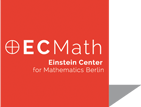Mathematics in Optical Technologies
The major challenges in our modern world are health, environment, energy, production, and security. They all are driven essentially by generation and manipulation of photons. That is why photonics is one of the key technologies of the 21st century. Major strategic plans of the U.S. government (Harnessing Light II – Photonics for 21st Century Competitiveness), of the European Commission (Strategic Research Agenda -- Lighting the way ahead), of the European Technology Platform Photonics21, and of the BMBF (Agenda Photonik 2020) acknowledge this trend. The Agenda Photonik 2020 confirms that optical technologies are Germany's most important future technologies and are even more important than the pharmaceutical industry.
To support the complex and rapidly developing optical technologies in
Berlin, ECMath supports research projects in the Innovation Area Mathematics in Optical
Technologies (MOT).
The mathematical research will broaden the research of the Matheon application area Electronic and Photonic devices.
The methods in Innovation Area MOT will span a whole range of mathematical disciplines, from mathematical physics as the modelling language, theory and numerical simulation of partial differential equations to solve high dimensional and multiscale problems to applied stochastics.
Projects
Prof. Dr. Alexander Mielke
Prof. Dr. Thomas Surowiec
Dr. Marita Thomas
Dr. Dirk Peschka
Description
The goal of the project Mathematical Modeling, Analysis, and Optimization of Strained Germanium-Microbridges is to optimize the design of a strained Germanium microbridge with respect to the light emission. It is a joint project with the Humboldt-University Berlin (M. Hintermüller, T. Surowiec) and the Weierstrass Institute (A. Mielke, M. Thomas), that also involves the close collaboration with the Department for Materials Research at IHP (Leibniz-Institute for Innovative High Performance Microelectronics, Frankfurt Oder).Website
X Close projectDr. M. Wolfrum
Description
Many modern photonic devices show complex dynamical features in space and time resulting from optical nonlinearities in active, often nanostructured materials. The project is focussed specifically on high-dimensional dynamical regimes in optoelectronic systems. Such a complex spatio-temporal behavior, in which nearly all modes are excited, is characterized by the fact that, in contrast to e.g. solitons or pulsations, it cannot be reduced to a low-dimensional description in terms of classical bifurcation theory. This so-called optical turbulence can be observed both in a Hamiltonian and in a dissipative context. A mathematical treatment of the resulting multi-scale and multi-physics problems presents major challenges for modelling, numerical, and analytical investigations. A simulation of the mostly 2+1 dimensional PDE-systems requires efficient parallelization strategies, instability mechanisms can be described only in terms of amplitude equations, and multi-scale effects in complex device structures can lead to singularly perturbed dynamical problems.Website
X Close projectDescription
Photonic crystals are periodic materials that affect the propagation of electromagnetic waves. They occur in nature (e.g. on butterfly wings), but they can also be manufactured. They possess certain properties affecting the propagation of electromagnetic waves in the visible spectrum, hence the name photonic crystals. The most interesting (and useful) property of such periodic structures is that for certain geometric and material configurations they have the so-called bandgaps, i.e., intervals of wavelengths that cannot propagate in the periodic structure. Therefore, finding materials and geometries with wide bandgaps is an active research area. Mathematically, finding such bandgaps for different configurations of materials and geometries can be modelled as a PDE eigenvalue problem with the frequency (or wavelength) of the electromagnetic field as the eigenvalue. These eigenvalue problems depend on various parameters describing the material of the structure and typically involve nonlinear functions of the searched frequency. The configuration of the periodic geometry may also be modified and can be considered a parameter. Finally, through the mathematical treatment of the PDE eigenvalue problem another parameter, the quasimomentum, is introduced in order to reduce the problem from an infinite domain to a family of problems, parametrised by the quasimomentum, on a finite domain. These are more accurately solvable. In order to solve the problem of finding a material and geometric structure with an especially wide bandgap, one needs to solve many nonlinear eigenvalue problems during each step of the optimization process. Therefore, the main goal of this project is to find efficient nonlinear eigensolvers. It is well-known that an efficient way of discretizing PDE eigenvalue problems on geometrically complicated domains is an adaptive Finite Element method (AFEM). To investigate the performance of AFEM for the described problems reliable and efficient error estimators for nonlinear parameter dependent eigenvalue problems are needed. Solving the finite dimensional nonlinear problem resulting from the AFEM discretization in general cannot be done directly, as the systems are usually large, and thus produce another error to be considered in the error analysis. Another goal in this research project is therefore to equilibrate the errors and computational work between the discretization and approximation errors of the AFEM and the errors in the solution of the resulting finite dimensional nonlinear eigenvalue problems.Website
X Close projectDescription
A typical trend in nanotechnology is to extend technology from basically 2D structures to 3D structures, from simple 2D layouts to complex 3D layouts. This has mainly two reasons: (i) There are fundamental physical effects bound to 3D structures, e.g., manifold properties in reciprocal space, and (ii) economic reasons as in semiconductor industry which enforce denser packaging and ever more complex functionalities.The automatic optimization of nano-photonic device geometries is becoming increasingly important and, due to enhanced complexity, increasingly difficult. Typical one-way simulations become unfeasible in many-query and real-time contexts. Model reduction techniques could be a way out. Potentially they offer online speed ups in the order of magnitudes. The reported success, however, is often linked to relatively simple structured objects. Slightly more complex examples fail immediately due to geometric and mesh constrains. To show the potential in real-world examples, however, complex 3D objects including comprehensive parametrizations have to be assembled.
The project aims to establish a link from 3D solid models obtained by CAD techniques, including full parametrizations, to reduced basis models. Establishing this critical link would facilitate systematic device geometry optimizations to be carried out using rigorous 3D electromagnetic field simulations. The main question is, how we can realize a large scale parametrization maintaining topologically equivalent meshes.
Website
X Close projectDescription
A number of emerging key technologies in microbiology, medical diagnostic devices, personal genomics, as well as next-generation low-energy OLED displays and liquid lenses make use of a phenomenon known as electrowetting on dielectric (EWOD). Electrowetting involves the manipulation of small (microscopic) droplets on a dielectric surface by the actuation of the underlying current. In fact, droplets in a typical EWOD device are situated between two separated hydrophobic surfaces, one of which contains an array of controllable electrodes. The air-liquid-solid contact angle can then by changed by varying the voltages on separate electrodes, which causes the droplets to move. Thus, the voltages are a natural choice for influencing (controlling) the motion of a droplet. The project pursues both sharp interface and phase field models, respectively, for the movement of droplets in an EWOD device. Both models make use of a macroscopic description for contact line pinning, which is due to contact angle hysteresis as well as molecular adhesion at the solid-liquid-air interface, for a faithful representation of the droplets velocity and cover different aspects properly. Due to the non-trivial dependencies on the moving interface in the sharp interface context, the proof of existence of an optimal control remains impossible without further restrictive assumptions or constraints, e.g., on the geometry, and the complexity of the phase field model poses severe challenges for a fast (real-time) numerical solution as needed for EWOD devices. For these reasons, instead of computing time-discrete or optimal controls the project work pursues an idea from model predictive control (MPC).Website
X Close projectDr. Karsten Tabelow
Description
Semiconductor quantum dots are nanostructures that form a technological path to innovative optoelectronic and photonic devices. Among them single quantum dots are promising candidates for single and entangled photon sources which are of importance for future quantum technologies such as quantum information processing, quantum cryptography, and quantum metrology. The growth of QDs with desired electronic properties would highly benefit from the assessment of QD geometry, distribution, and strain profile in a feedback loop between growth and analysis of their properties. In this project, we will therefore develop a novel 3D model-based geometry reconstruction (MBGR) of QDs. This will include an appropriate model for the QD configuration in real space, a characterization of corresponding simulated TEM images as well as a statistical procedure for the estimation of QD properties and classification of QD types based on acquired TEM image data. The MBGR approach will enable a high-throughput characterization of QD samples by TEM via QD geometry, distribution and strain field. Furthermore, it will provide a guiding example for mathematically enhanced microscopy for the reconstruction of other nanoscale objects in different applications.Website
X Close projectDescription
The goal of the Matheon project D-OT8: Modeling, analysis, and optimization of optoelectronic semiconductor devices driven by experimental data is to optimize the design of a strained germanium microbridge with respect to the light emission. In the funding period June 2016-December 2018 we will develop tools for the parameter identification and optimal design of experiment for optoelectronic applications. The project also involves the close collaboration with the Department for Materials Research at IHP (Leibniz-Institute for Innovative High Performance Microelectronics, Frankfurt Oder).Website
X Close projectProf. Dr. Frank Schmidt
Description
This project investigates methods to model and simulate nanoscale light emitters in complex environments. Semiconductor quantum dots can be used as light sources in quantum information processing. Typical applications like secure communication or quantum-computing require integration of quantum dots into optical nanostructures. For the analysis and design of such structures and their interaction with radiation emitted by the quantum dots, numerical modeling and simulations are essential. In this project we concentrate on the specific problems arising when pointlike sources like quantum dots are interacting with nanostructures which support optical resonances. We plan to develop, extend and analyze methods for efficiently simulating coupling to optical resonators with material dispersion and for methods for handling coupled resonators.Website
X Close projectProf. Dr. Volker Mehrmann


